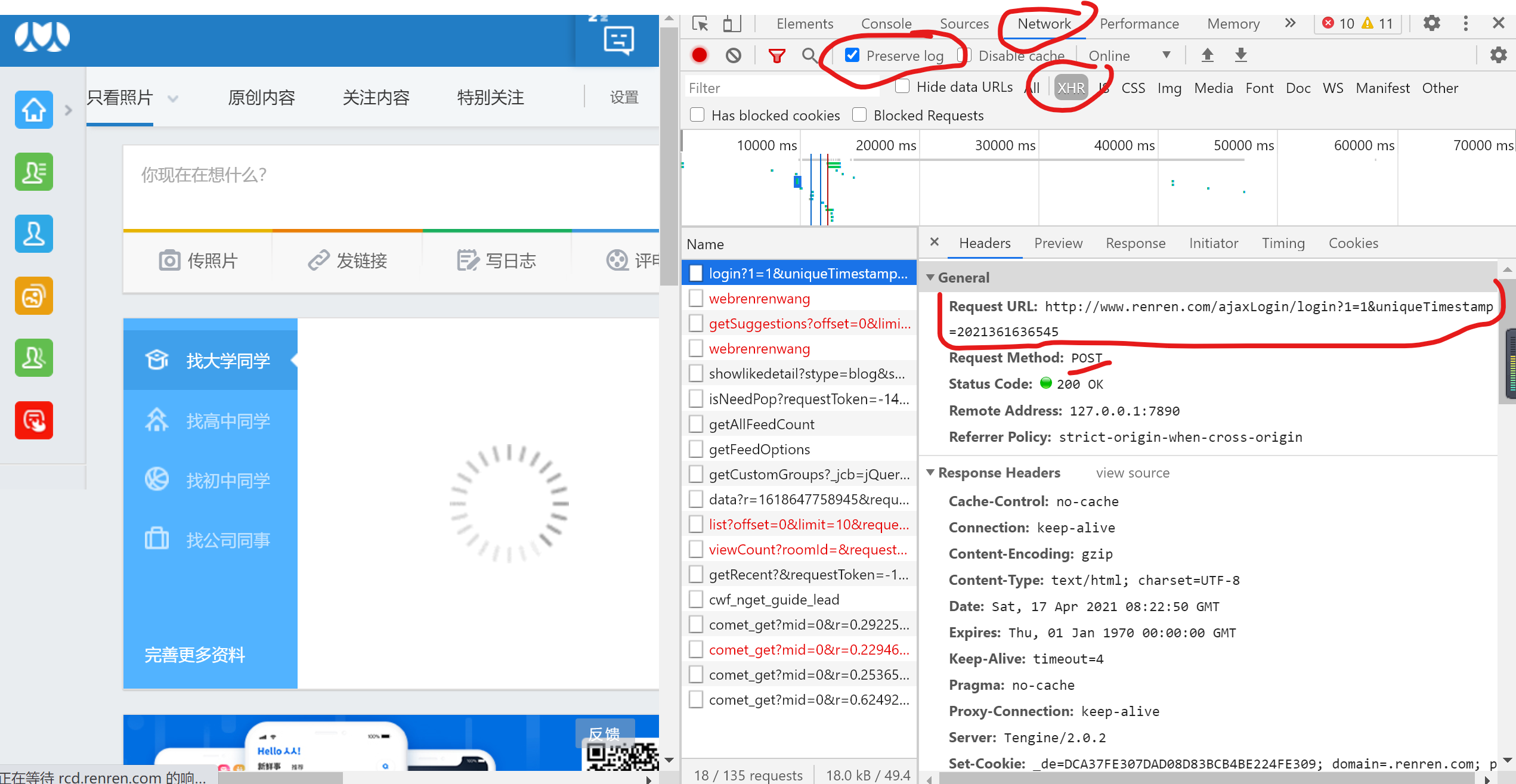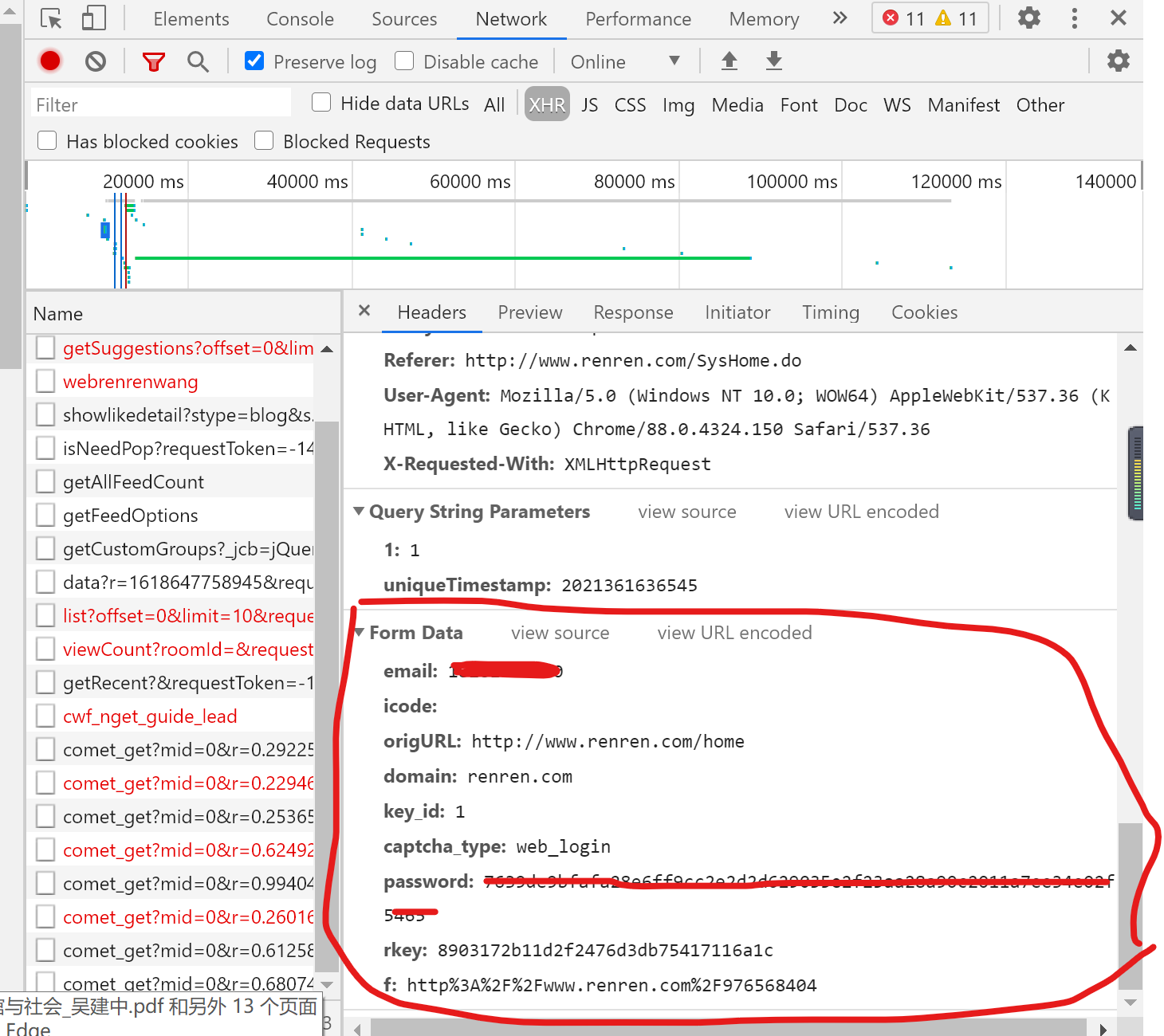Simulated landing
note
1. Simulated Login: crawl user information based on some users.
2. Demand: simulated Login of Renren.
-① After clicking the login button, a post request will be initiated
-② The post request will carry the relevant login information (user name, password, verification code...) entered before login
-③ Verification Code: each request will change dynamically
3. Requirements: crawl the relevant user information of the current user (user information displayed in the personal home page)
4.http/https protocol features: stateless.
5. Why the corresponding page data is not requested: when the second request based on the personal home page is initiated, the server does not know that the request is based on the request in login status
6.cookie: used to let the server record the relevant status of the client.
- Manual processing: obtain the cookie value through the packet capture tool and encapsulate the value into headers (not recommended)
- Automatic processing:
- Where does the cookie value come from?
- After simulating the login post request, it is created by the server
- session object:
- ① Function: 1 The request can be sent; 2. If the cookie is carried during the request / session, the cookie will be automatically generated
- ② Create a session object: session = requests Session()
- ③ Use the session object to simulate login and send the post request (the cookie will be stored in the session)
- ④ The session object sends the get request corresponding to the personal homepage (carrying a cookie)
7. Proxy: crack the anti crawling mechanism of ip
① What is proxy: proxy server
② The role of agent: break through the restriction of its own ip access; You can hide your real ip from attack
③ Type of proxy ip: - http: applied to the url corresponding to HTTP protocol- https: apply to the url corresponding to https protocol
④ Anonymity of proxy ip:
Transparency: the server knows that the proxy is used for the request and the real ip address corresponding to the request
Anonymity: I know that the proxy is used, but I don't know the real ip address
Gao Ni: I don't know the proxy is used, let alone the real ip address
actual combat
Simulated Login to Renren


import requests
from lxml import etree
from CodeClass import Chaojiying_Client
def getCodeText(imgPath, codeType):
chaojiying = Chaojiying_Client('user name', 'password', 'Software ID') # User center > > software ID generates a replacement 96001
im = open(imgPath, 'rb').read() # Local image file path to replace a.jpg. Sometimes WIN system needs to//
return chaojiying.PostPic(im, codeType) # 1902 verification code type official website > > price system version 3.4 + print to add ())
#1. Capture and identify the verification code picture
url = 'http://www.renren.com/SysHome.do'
headers = {
'User-Agent':
'Mozilla/5.0 (Windows NT 10.0; Win64; x64; rv:86.0) Gecko/20100101 Firefox/86.0',
}
page_text = requests.get(url = url,headers=headers).text
tree = etree.HTML(page_text)
code_img_src = tree.xpath('//*[@id="verifyPic_login"]/@src')[0]
code_img_data = requests.get(url=code_img_src,headers=headers).content
with open('./code.jpg','wb') as fp:
fp.write(code_img_data)
#Use the example code provided by super eagle to identify the verification code picture
result = getCodeText('code.jpg',1005)
#Sending of post request (simulated Login)
login_url = 'http://www.renren.com/ajaxLogin/login?1=1&uniqueTimestamp=2021361636545'
data = {
'email': 'user name',
'icode':result,
'origURL': 'http://www.renren.com/home',
'domain': 'renren.com',
'key_id': 1,
'captcha_type': 'web_login',
'password': '',
'rkey': 'd0cf42c2d3d337f9e5d14083f2d52cb2',
'f': 'http%3A%2F%2Fwww.renren.com%2F976568404%2Fprofile'
}
response = requests.post(url = login_url,headers = headers,data=data)
print(response.status_code)
login_page_text = response.text
with open('renren.html','w',encoding = 'utf-8') as fp:
res = fp.write(login_page_text)
Crawl the personal details page data of current users of Renren
#Coding process:
#1. Identify the verification code and obtain the text data of the verification code picture
#2 send the post request (processing request parameters)
#3 persistent storage of corresponding data
import requests
from lxml import etree
form CodeClass import Chaojiying_Client
def getCodeText(imgPath,codeType):
chaojiying = Chaojiying_Client('user name', 'password', 'Software ID') # User center > > software ID generates a replacement 96001
im = open(imgPath, 'rb').read() # Local image file path to replace a.jpg. Sometimes WIN system needs to//
return chaojiying.PostPic(im, codeType) # 1902 verification code type official website > > price system version 3.4 + print to add ())
#Create a session object
session = requests.Session()
#1 capture and identify the verification code picture
url = 'http://www.renren.com/SysHome.do'
headers = {
'User-Agent':
'Mozilla/5.0 (Windows NT 10.0; Win64; x64; rv:86.0) Gecko/20100101 Firefox/86.0',
}
page_text = requests.get(url=url,headers=headers).text
tree =etree.HTML(page_text)
code_img_src = tree.xpath('//*[@id="verifyPic_login"]/@src')[0]
code_img_data = requests.get(url=code_img_src,headers=headers).content
with open('./code.jpg','wb') as fp:
fp.write(code_img_data)
#Use the sample code provided by super eagle to identify the verification code picture
result = getCodeText('code.jpg',1005)
#Sending of post request (simulated Login)
login_url = 'http://www.renren.com/ajaxLogin/login?1=1&uniqueTimestamp=2021361636545'
data = {
'email': 'user name',
'icode':result,
'origURL': 'http://www.renren.com/home',
'domain': 'renren.com',
'key_id': 1,
'captcha_type': 'web_login',
'password': '',
'rkey': 'd0cf42c2d3d337f9e5d14083f2d52cb2',
'f': 'http%3A%2F%2Fwww.renren.com%2F976568404%2Fprofile'
}
#Send post request using session
response = session.post(url=login_url,headers=headers,data=data)
print(response.status_code)
#Crawl the page data corresponding to the current user's personal home page
detail_url = 'http://www.renren.com/976568404/profile'
#Manual cookie processing (not universal)
#headers = {'cookis':''}
#Send get request using session with cookie
detail_page_text = session.get(url=detail_url,headers=headers).text
with open('jj.html','w',encoding='utf-8') as fp:
fp.write(detail_page_text)
enclosure
Super Eagle code
File library name CodeClass
import requests
from hashlib import md5
class Chaojiying_Client(object):
def __init__(self, username, password, soft_id):
self.username = username
password = password.encode('utf8')
self.password = md5(password).hexdigest()
self.soft_id = soft_id
self.base_params = {
'user': self.username,
'pass2': self.password,
'softid': self.soft_id,
}
self.headers = {
'Connection': 'Keep-Alive',
'User-Agent': 'Mozilla/4.0 (compatible; MSIE 8.0; Windows NT 5.1; Trident/4.0)',
}
def PostPic(self, im, codetype):
"""
im: Picture byte
codetype: Topic type reference http://www.chaojiying.com/price.html
"""
params = {
'codetype': codetype,
}
params.update(self.base_params)
files = {'userfile': ('ccc.jpg', im)}
r = requests.post('http://upload.chaojiying.net/Upload/Processing.php', data=params, files=files, headers=self.headers)
return r.json()
def ReportError(self, im_id):
"""
im_id:Pictures of wrong topics ID
"""
params = {
'id': im_id,
}
params.update(self.base_params)
r = requests.post('http://upload.chaojiying.net/Upload/ReportError.php', data=params, headers=self.headers)
return r.json()